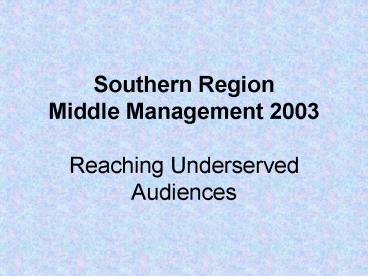Southern Region Middle Management 2003 Reaching Underserved Audiences - PowerPoint PPT Presentation
1 / 21
Title:
Southern Region Middle Management 2003 Reaching Underserved Audiences
Description:
Inform our Extension clientele through newsletters. Why be concerned about underserved audiences? ... differences among clientele base. Changing demographics ... – PowerPoint PPT presentation
Number of Views:27
Avg rating:3.0/5.0
Title: Southern Region Middle Management 2003 Reaching Underserved Audiences
1
Southern Region Middle Management 2003Reaching
Underserved Audiences
2
Today
- Group interaction
- Points of reference
- Implementation strategies in Virginia
- Sharing efforts and successes in your states
3
Why be concerned about underserved audiences?
- We already
- Promote educational programs through print media
- Market on radio and TV
- Circulate flyers to schools and other public
locations - Inform our Extension clientele through
newsletters
4
Why be concerned about underserved audiences?
- We already
- Advertise programs as nondiscriminatory and open
to the public - They must not think our programs are beneficial
- Some of them say they want our programs but never
show up - We have great educational programs for them but
they dont seem to be interested
5
Why should we be concerned about underserved
audiences?
- Cooperative Extension has a history of not
serving all segments of the community - Preconceived notions about our programs
- Potential clients unaware of our needs-based
programming process - Inability to access our information
- Multiple differences among clientele base
- Changing demographics in communities
6
Why should we be concerned about underserved
audiences?
- Diverse groups of people and organizations should
be engaged in a collaborative process for
determining community needs - Groups should be demographically representative
of the community - True engagement can create a sense of ownership
and support for programs - Federal, state, and local expectations dictate
that programs be far-reaching
7
Considerations for Underserved
- Age
- Class
- Community status
- Culture
- Disabled
- Educational level
- Ethnicity
- Gender
- Geographic location
- Income
- Income
- Language
- Limited access to technology
- Literacy
- Race
- Religion
- Sexual orientation
- Transportation availability
8
How do we identify the underserved in a community?
- Conduct a situation analysis to determine
population makeup of community/area to be served - Develop community/area profiles
- Determine if program participants are (contacts)
reflective of the defined community demographics? - Determine which segments are not participating in
our programs
9
Basics for reaching underserved audiences
- Involve a diverse cross-section of people in the
identification of community needs - Facilitate community participation in Extension
education programs - Express the expectation that faculty and staff be
committed to reaching underserved populations - Evaluate outreach strategies, efforts, and
outcomes - Leadership must be committed to doing the right
things
10
Virginia practices for reaching underserved
audiences
- Agent Personal Action Plans include specific
planned outreach strategies and educational
activities for including underserved audiences - Consider more than just race and gender
- Planned strategies and efforts are discussed and
approved by District Director - Strategies, efforts, and outcomes are considered
during annual evaluation
11
(No Transcript)
12
Extension Leadership Councils (ELCs)
- The primary means for Virginia Cooperative
Extension (VCE) to facilitate community
participation in Extension educational
programming.
13
Extension Leadership Councils
- Are representatives of the community
- Primary partner for community involvement
- Key to VCE Being a Community Resource that is
Meeting the Needs of Virginias Communities
14
ELC Mission
- To develop and implement a program plan that will
direct Extensions resources toward the
resolution of identified issues and concerns.
15
ELC Vision
- To identify the needs and concerns that exist in
their planning area and share a commitment to
determining solutions, implementing them, and
evaluating and reporting results.
16
Membership
- The group will be diverse in terms of race,
ethnic origin, color, religion, sex, age, veteran
status, national origin, disability, or political
affiliation.
17
Membership
- The diversity of the group enhances discussions,
deliberations, and actions. There is an
acknowledgement that each person brings unique
experiences and information that will contribute
to the process.
18
Membership
- Consider personal characteristics, access to
community resources, geographic representation,
skills and expertise, current involvement,
self-interest, and a willingness and ability to
commit and participate in the ELC partnership.
19
Roles and Functions of an ELC
- Identify community problems, concerns, and issues
- Assess current Extension programs
- Identify other possible opportunities for
cooperation and collaboration - Design and implement program plan
- Monitor and adjust program efforts
- Evaluate and report results
- Advocate for Extension and its programs
20
(No Transcript)
21
http//natldiversity.extension.oregonstate.edu/ind
ex.htm

